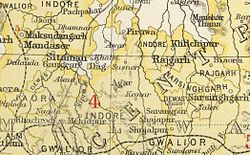| Narsinghgarh State | |||||||
|---|---|---|---|---|---|---|---|
| Princely State | |||||||
| 1681–1948 | |||||||
 Narsinghgarh State in the Imperial Gazetteer of India | |||||||
| Capital | Narsinghgarh | ||||||
| Area | |||||||
• 1948 | 1,920 km2 (740 sq mi) | ||||||
| Population | |||||||
• 1948 | 140,000 | ||||||
| History | |||||||
• Established | 1681 | ||||||
| 1948 | |||||||
| |||||||

The Kingdom of Narsinghgarh also known as Narsinghgarh State was a princely state located in present-day Madhya Pradesh, India with its capital at Narsinghgarh from which the state was named. The ruling family was a cadet branch of the royal family of Rajgarh State. [1]
Contents
It formed an enclave within Rajgarh State and was placed administratively under the Bhopal Agency subdivision of the Central India Agency. [2] The state covered an area of 1,920 square kilometres (740 sq mi) and had a population of 92,093 and an average revenue of Rs.5,00,000 in 1901. [3] [2] [4]
The state capital was the town of the same name, Narsinghgarh. [1]


